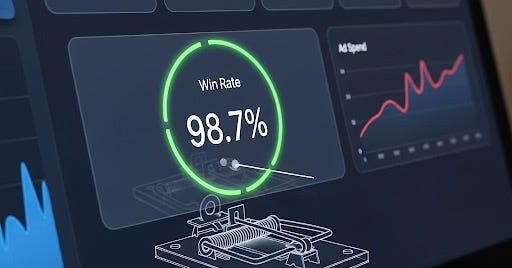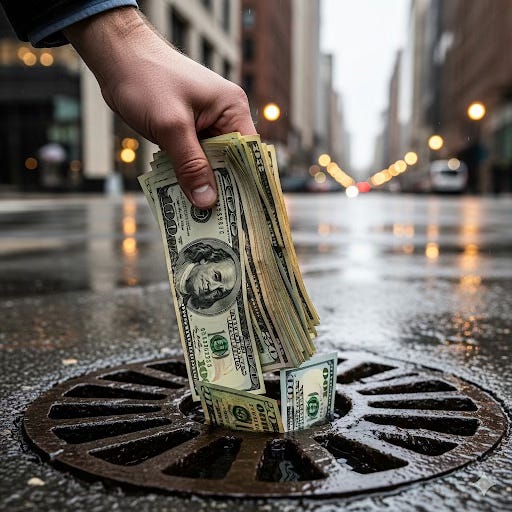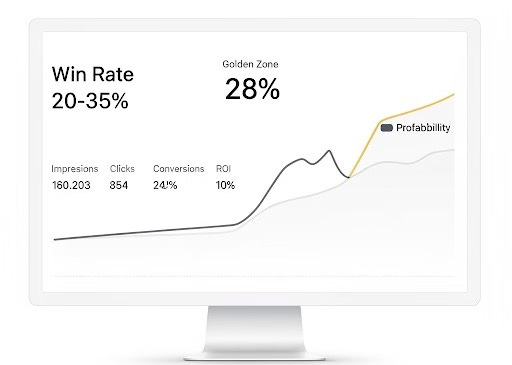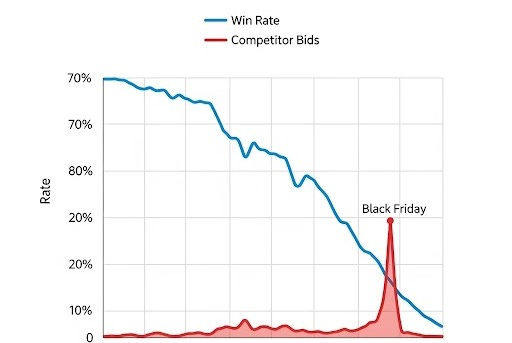The Precision Playbook Series: Escaping the Win Rate Illusion
The Win Rate Illusion: Is a High Win Rate a Sign of Success or a Trap?
In the digital ad world, there's a metric that feels like a badge of honor: The Win Rate. It’s a simple number that tells you how often your bids are winning auctions. The conventional wisdom is straightforward in that a high win rate is good. It means you’re winning the impressions you want. It means your bids are aggressive and you’re reaching your audience.
This series is for the marketers who are tired of the same old advice. It's for the ones who know that true value of a campaign is measured in profitability, not just traffic. I’m going to pull back the curtain on some of these that separate the pros from the rookies.
Each installment will challenge a conventional wisdom and provide a step-by-step guide to a tactic that will change the way you think about your campaigns. Hopefully you will be able to find the signal in the noise and prove your true incremental value.
What if I told you that a high win rate could be the first sign that you are overpaying, and that a low win rate is often a sign of a more disciplined, profitable campaign?
The truth is the win rate, on its own, is a vanity metric. True campaign mastery isn’t about winning the most auctions but winning the right auctions at the right price.
The rookie is focused on winning. The pro is focused on earning.
This series installment is meant to challenge the idea that you should always strive for a high win rate and show you why a high win rate can be a symptom of a bloated strategy and how to use this metric as a tool for unlocking real profitability.
Why a High Win Rate Can Be a Trap
In a programmatic auction, every impression has a price. When you have a high win rate, 80-90%, it means you are consistently outbidding almost every other advertiser for the impressions you are bidding on. In a 1st party auction, you’re paying what you are bidding too, which makes this even more important. Instead of a 2nd party auction where you pay $ 0.01 over the next highest bid.
The DSP's job is to find the most expensive inventory that still meets your performance goals. In a 1st party auction, if your bid is $5 and the next highest is $0.50, you are still getting that impression at $5 and you're probably leaving a lot of money on the table.
A high win rate is a red flag that you're in a bidding vacuum. You're so far ahead of the competition that you are paying a premium for inventory you could get for way less.
The Pro's Secret: Using Win Rate for Profitability
The smartest media buyers view win rate not as a goal but more as a diagnostic tool.
The ideal win rate is usually in the 20-35% range. In this Golden Zone, it’s competitive enough to secure a meaningful amount of inventory but you're also losing enough that the algorithm is being forced to find more efficient impressions. You are in a healthy competition in that you're not overpaying.
A Step-by-Step Guide to Optimizing for Profitability, Not for Win Rate
Baseline Your Current Win Rate Go into your campaign reporting and find your current win rate.
The Incremental Bid Reduction Test Just like the low-bid campaign from our last article, we’re going to run a controlled test. Start by making a slight reduction to your bid (a 10% decrease to start)
Monitor the Change Run the campaign for a week and see what happens to your key metrics.
What happens to your win rate? It will likely drop, perhaps from 80% to 65%.
What happens to your performance metrics? If your ROAS stays the same or improves, you have found a way to maintain performance while spending less. You have proven incremental value without the high win rate premium.
Iterate and Repeat: Continue to incrementally decrease your bid and monitor your performance and you’ll find the sweet spot where your win rate drops too low (<20%) and your performance metrics begin to suffer. Call this your Profitability Floor. You can then set your bids just above this floor to maximize efficiency.
This process forces you to be a more disciplined buyer. You are no longer just letting the algorithm do what it wants but instead you are actively guiding it to find the most efficient and profitable path.
The Seasonal Impact: The Invisible Force on Your Win Rate
Before you get started, there is one more external factor every pro monitors: Seasonality. It's a fundamental principle of economics that applies directly to win rates.
Think about the period between Black Friday and Cyber Monday. This is a time of immense demand and a massive influx of ad spend. Advertisers across the board are willing to pay more to capture holiday shoppers.
What this means for your win rate During these peak periods, the bids of your competitors are skyrocketing. Even if you maintain your normal bids, your win rate will drop like a brick. The inventory is the same but the competition is now far more aggressive.
The rookie's reaction The amateur will panic see the low win rate, and instinctively raise bids getting caught in an all out expensive bidding war and paying a premium for a lot of the same traffic they could get later.
The pro's reaction The professional understands that this is a predictable market fluctuation. They will accept the lower win rate knowing that the most valuable impressions are now prohibitively expensive. They might even hold off on some campaigns until the new year when competition dies down and their bids become efficient again. They know to keep their head and their discipline, because the market, not their strategy, has changed.
So, when you see a sudden, sharp change in your win rate, look at your calendar first. Is it a major holiday? Is it the end of a fiscal quarter? Understanding these market forces is the first step to making smarter decisions.
"Okay, but what about audience reach?"
A common objection to this strategy is that a low win rate means you're not reaching your entire target audience. This is where the true strategic mindset comes in.
Instead of paying a premium to win every impression in a small, competitive pool, you are now forcing your campaign to explore a wider and less competitive range of impressions. By lowering your bid, you’re opening up opportunities for the algorithm to find valuable and cheaper inventory. This could be impressions that are available in a different geo at a different time of day or on a different site or app all for a fraction of the cost.
So, while your win rate on the "high-demand" impressions may be lower, your overall campaign reach and profitability can actually increase. You're not winning every battle, but you're winning the war on profitability.
The Advanced Nuance: When a High Win Rate Is Everything
Now, for the exception that proves the rule. While the Golden Zone holds true for most programmatic buying, there are scenarios and platforms where the economics are completely different.
Take a more sophisticated platform like Beeswax, for example, which operates on a query model. Unlike the traditional DSP that bids on millions of random impressions, Beeswax allows advertisers to bid on specific, specially designed queries. The actual bid requests coming in from the supply-side. This is the Bidder-as-a-Service model.
In this environment, the game changes entirely. The core economics are not about finding cheap inventory in a bidding war; they are about winning as many of the relevant, pre-vetted, pre-paid queries as possible.
Why?
You've Already Vetted the Inventory You’re not wasting time or money filtering out junk. You’ve already done the hard work of creating inclusion lists and a very precise bidding strategy while building your query templates. You’re only bidding on inventory that is relevant and high value from the start.
The Cost is in the Query, Not the Win Beeswax's business model is a fixed monthly fee for 10K, 20K etc QPS or queries per second and not a percentage of ad spend. You are literally paying per query to receive the opportunity to bid.
The Economics of Scale Since you are paying a fixed cost for the opportunity to bid a low win rate is a direct waste of money. A higher win rate on these pre-qualified queries means you are converting your fixed cost into a higher percentage of valuable impressions. Your campaign becomes more efficient as your win rate increases because you are leveraging the fixed infrastructure cost more effectively.
In this world, a high win rate isn't a red flag but a sign of success (and profitability). You’ve done the hard work of segmenting the market, and now a high win rate means your campaign is performing exactly as intended.
So, there you have it. The second rule of leaving the bidding war behind is to understand that the value of your win rate is entirely dependent on the platform and the buying strategy you are deploying.
The truth is in the data, and I'd be honored to hear what you uncover.





